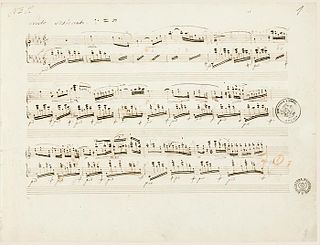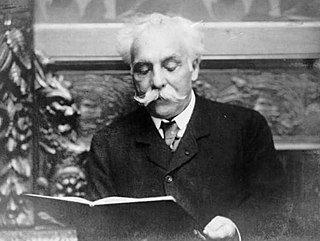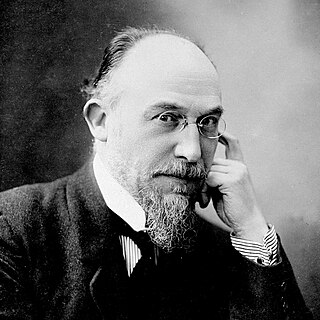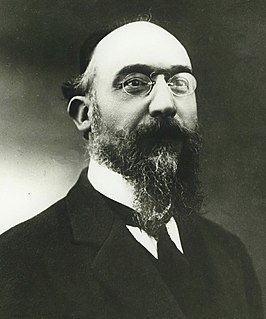| Look up nocturnes in Wiktionary, the free dictionary. |
Nocturnes are musical compositions inspired by, or evocative of, night.
Contents
Nocturnes may also refer to:
| Look up nocturnes in Wiktionary, the free dictionary. |
Nocturnes are musical compositions inspired by, or evocative of, night.
Nocturnes may also refer to:

(Achille) Claude Debussy was a French composer. He is sometimes seen as the first Impressionist composer, although he vigorously rejected the term. He was among the most influential composers of the late 19th and early 20th centuries.

A nocturne is a musical composition that is inspired by, or evocative of, the night.
A prelude is a musical form. It may also refer to:
A nocturne is a musical composition inspired by, or evocative of, night.

Peter Roy Katin was a British classical pianist and teacher.

The Nocturnes, Op. 27 are a set of two nocturnes for solo piano composed by Frédéric Chopin. The pieces were composed in 1836 and published in 1837. Both nocturnes in this opus are dedicated to Countess d'Appony.

Frédéric Chopin's Berceuse, Op. 57, is a lullaby to be played on the piano. He composed it in 1843/44 as variations in D-flat major. Chopin originally called his work Variantes. Berceuse was first published in Paris in 1844 by Jean-Racine Meissonnier, dedicated to Élise Gavard, and appeared in London and Leipzig the following year.

Stéphane Raoul Pugno was a French composer, teacher, organist, and pianist known for his playing of Mozart's works.
Frédéric Chopin wrote 21 nocturnes for solo piano between 1827 and 1846. They are generally considered among the finest short solo works for the instrument and hold an important place in contemporary concert repertoire. Although Chopin did not invent the nocturne, he popularized and expanded on it, building on the form developed by Irish composer John Field.
Three Nocturnes can refer to
Tzvi Erez is an Israeli–Canadian pianist. He was born in Israel and began his piano studies at the age of six. He moved to Canada and graduated from The Royal Conservatory of Music, where he trained with Mildred Kenton, Andrew Burashko, and Antonin Kubalek. Erez has released over 33 albums worldwide, including Bach’s Well-Tempered Clavier, Partita 2, Goldberg Variations, Two-Part Inventions; Beethoven’s Piano Works, Sonatas, Piano Concerto No. 3; Chopin’s Complete Ballades, Etudes, Preludes, Piano Concertos No. 1 & 2; Debussy’s Suite Bergamasque; Liszt Piano Recital; Erik Satie’s Gymnopedies, Gnossiennes, and Cold Pieces; Mussorgsky’s Pictures at an Exhibition; Essential Classics, Masterpieces, Sentimental, Mozart’s Piano Sonatas, Rachmaninoff's Concerto No. 2 & 3, the Grieg Piano Concerto, the Robert Schumann Piano Concerto, the Tchaikovsky Piano Concerto, and others. Erez is active in new classical recordings, teaching piano performance and classical music research. He also assists artists in production and produced several film scores and music for television shows.

The French composer Gabriel Fauré (1845–1924) wrote in many genres, including songs, chamber music, orchestral pieces, and choral works. His compositions for piano, written between the 1860s and the 1920s, include some of his best known works.

The Nocturnes are five piano pieces by Erik Satie. They were written between August and November 1919. With the exception of the Premier Menuet (1920) they were his final works for solo piano, and are considered among his most significant achievements in the genre. The Nocturnes stand apart from Satie's piano music of the 1910s in their complete seriousness, lacking the zany titles, musical parody, and extramusical texts he typically featured in his scores of the time. In performance the set lasts about 13 minutes.

The Avant-dernières pensées is a 1915 piano composition by Erik Satie. The last of his humoristic piano suites of the 1910s, it was premiered by the composer at the Galerie Thomas in Paris on May 30, 1916, and published that same year. A typical performance lasts 3–4 minutes.
In music, Op. 28 stands for Opus number 28. Compositions that are assigned this number include:

Croquis et agaceries d'un gros bonhomme en bois, translated as Sketches and Exasperations of a Big Wooden Dummy, is a 1913 piano composition by Erik Satie. One of his pre-World War I "humoristic" suites, it was published by E. Demets that same year. Ricardo Viñes gave the premiere during a concert of the Société Nationale de Musique at the Salle Pleyel in Paris on March 28, 1914. A typical performance lasts about five minutes.

Chapitres tournés en tous sens(Chapters Turned Every Which Way) is a 1913 piano composition by Erik Satie. One of his "humoristic" keyboard suites of the 1910s, it was published by the firm E. Demets that year. Ricardo Viñes gave the premiere at the Salle Erard in Paris on January 14, 1914. In performance it lasts about 5 minutes.